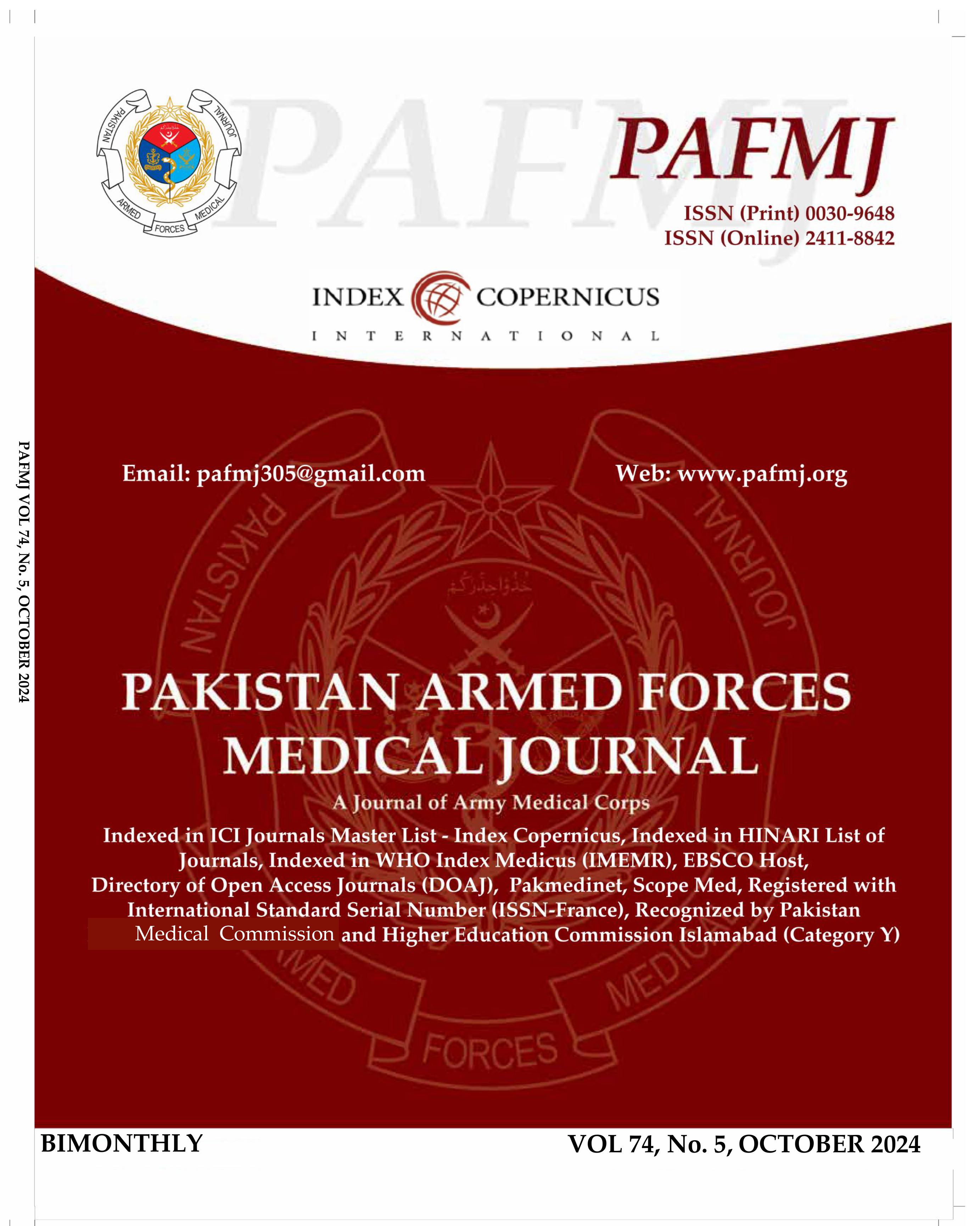Switching Trends in Medical Education: Faculty Perception
DOI:
https://doi.org/10.51253/pafmj.v74i5.9123Keywords:
Integrated modular system, Medical education, Traditional teachingAbstract
Objective: To determine the level of awareness among faculty members of Sindh Medical College regarding switching trends in medical education from traditional to integrated modular system.
Study Design: Qualitative study (Phenomenology).
Place and Duration of Study: Sindh Medical College, Karachi Pakistan, from Nov 2019 to Jan 2020.
Methodology: The perception of 32 faculty members working in Sindh Medical College regarding Integrated Modular System (IMS) was explored through interviews, where participants were asked 12 open-ended questions, responses were coded, and theme and subthemes were drawn.
Results: Based on the participant’s view, an integrated modular curriculum offers a more comprehensive approach to teaching. The majority of faculty believed that if only horizontal mode of IMS is implemented, it will be more effective and helpful for students to acquire in-depth knowledge.
Conclusion: The findings of the study suggest that IMS is a better option for medical education with the majority of faculty favoring horizontal IMS.
Downloads
References
Haque A, Mansoor S, Malik F, Ahmed J, Haque Z. Comparison of quality of life of medical students in annual and modular systems in public sector medical colleges in Karachi, Pakistan. Int J Med Stud 2022; 10(3): 258-263.
https://doi.org/10.5195/ijms.2022.1028
Uneeb S, Zainab A, Khoso A, Basit A. Knowledge scores in annual and modular curriculum among medical students from Karachi, Pakistan. J Pak Med Assoc 2021; 71(2): 681-685. https://doi.org/10.47391/JPMA.1416
Rahman S. Transition from traditional curriculum to modular curriculum possible challenges. J Gandhara Med Dent Sci 2022; 9(3): 1-2. https://doi.org/10.37762/jgmds.9-3.328
Gullo C, Dzwonek B, Miller B. A disease-based approach to the vertical and horizontal integration of a medical curriculum. Med Sci Educ 2015; 26(1): 93-103.
https://doi.org/10.1007/s40670-015-0208-5
Jalil SA, Usmani A. Evaluation of undergraduate integrated modular teaching system. J Pak Orthop Assoc 2022;34(4).
Atwa HS, Gouda EM. Curriculum integration in medical education: a theoretical review. Intel Prop Rights 2014; 2(2): 113. https://doi.org/10.4172/2375-4516.1000113
Brauer DG, Ferguson KJ. The integrated curriculum in medical education: AMEE Guide No. 96. Med Teach 2014; 37(4): 312-22. https://doi.org/10.3109/0142159X.2014.970998
Quintero GA, Vergel J, Arredondo M, Ariza MC, Gómez P, Pinzon-Barrios AM. Integrated medical curriculum: advantages and disadvantages. J Med Educ Curric Dev 2016; 3: 133-137.
https://doi.org/10.4137/JMECD.S18920
Kalpana Kumari MK, et al. Students’ perception about integrated teaching in an undergraduate medical curriculum. Indian J Basic Appl Med Res 2011; 5(6): 1256-1259.
Karthikeyan K, Kumar A. Integrated modular teaching in dermatology for undergraduate students: a novel approach. Indian Dermatol Online J 2014; 5(3): 266-270.
https://doi.org/10.4103/2229-5178.13777
Waqar T, Khaliq T. Integrated-modular system for undergraduate medical students: faculty’s perception. Pak Armed Forces Med J 2019; 69(3): 465-471.
Nasim M. Medical education needs to change in Pakistan. J Pak Med Assoc 2011; 61(8): 808-811.
Khalid T. Curriculum integration; a strategy for better patient care. J Univ Med Dent Coll 2015; 6(1): iii-iv.
Chih-Pei HU, Chang YY. John W. Creswell, research design: qualitative, quantitative, and mixed methods approach. J Soc Adm Sci 2017; 4(2): 205-207.
Creswell J, Guetterman T. Educational research: planning, conducting, and evaluating quantitative and qualitative research, 6th ed. 2018.
Maryam W. Integrated medical teaching – current scenario. Anat Physiol Biochem Int J 2016; 1(1): 555551.
https://doi.org/10.19080/APBIJ.2016.01.555551
Eikelboom JI, ten Cate OT, Jaarsma D, Raat JA, Schuwirth L, van Delden JJ. A framework for the ethics review of education research. Med Educ 2012; 46(8): 731-733.
https://doi.org/10.1111/j.1365-2923.2012.04293.x
Illing J. Understanding medical education: evidence, theory, and practice. 2nd ed. UK: John Wiley & Sons, Ltd; 2014. Chapter 24. Thinking about research: theoretical perspectives, ethics, and scholarship. 331-349.
Quintero GA, Vergel J, Arredondo M, Ariza MC, Gómez P, Pinzon-Barrios AM. Integrated medical curriculum: advantages and disadvantages. J Med Educ Curric Dev 2016; 3: 333-337. https://doi.org/10.4137/JMECD.S18920
Basu M, Chowdhury G, Das P. Introducing integrated teaching and comparison with traditional teaching in undergraduate medical curriculum: a pilot study. Med J Dr DY Patil Univ 2015; 8(4): 431-38. https://doi.org/10.4103/0975-2870.160778
Yamani N, Rahimi M. The core curriculum and integration in medical education. Res Dev Med Educ 2016; 5(2): 50-54. https://doi.org/10.15171/rdme.2016.011
Downloads
Published
Issue
Section
License
Copyright (c) 2024 Tazeen Shah, Talat Zehra, Zareen Irshad, Binish Arif Sultan, Gull Afshan, Yasmin Wahid

This work is licensed under a Creative Commons Attribution-NonCommercial 4.0 International License.















